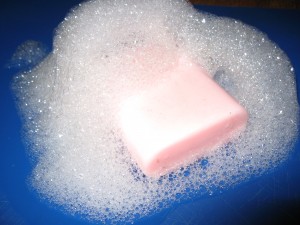You need 3 main ingredients to make soap
Water
Water is a key ingredient in soap making. A highly mineralized water (hard water) would hinder good saponification. Thus it is recommended that you use a low mineralized water such as rain water or distilled water.
Caustic alkali
Sodium hydroxide, or caustic soda, comes as little white tablets or balls. It is a very dangerous product, one must be very cautious when handling it. You may wear rubber gloves up to the elbow, long sleeves, and eye protection glasses while handling it. You could wear thick fabric trousers and a plastic apron as well. It would also be wise to wear rubber boots.
Never forget that caustic soda is corrosive, noxious and dangerous. It must be operated preferably in a well-ventilated area. You must ensure that you do not inhale chemical reaction fumes. The best would be to operate in the open – in a garden or on a balcony.
You must take care to proceed in small quantities, especially if it is to make several kinds of soaps in different colours and various fragrances.
Use preferably glass containers, dedicated to soap making.
In the event of a contact of the skin with soda, you should rinse the affected skin immediately under tap water. In the event of a splashing in the eye, you must rinse abundantly and seek immediate medical advice.
The alkali can also be made from ashes; it is then potassium hydroxide KOH (potash) which is at work.
The major difference between caustic soda and potash is that the first one produces hard soap while the second one produces soft soap.
Oils or fats
Any fat can be used for soap making. The end results will vary according to the fat used. For instance, if you would like a soap that lathers a lot, you should use 20% to 25% of coconut oil. You must be aware, however, that lather does not improve the washing property of the soap at all. It is no more than a psychological element.
Other additives are optional but are of supreme importance for giving your soap its personal touch, its main characteristics. They are what will make your own soap so special: essential oils for specific treatments and fragrances, colouring for the eye, and various other products such as honey, milk, wax, clay, dried herbs, flowers, chopped oatmeal, cornmeal, cocoa powder, … the list is pretty long.
To find out the details on how to make soap, follow this link to Soap Making Technique.
